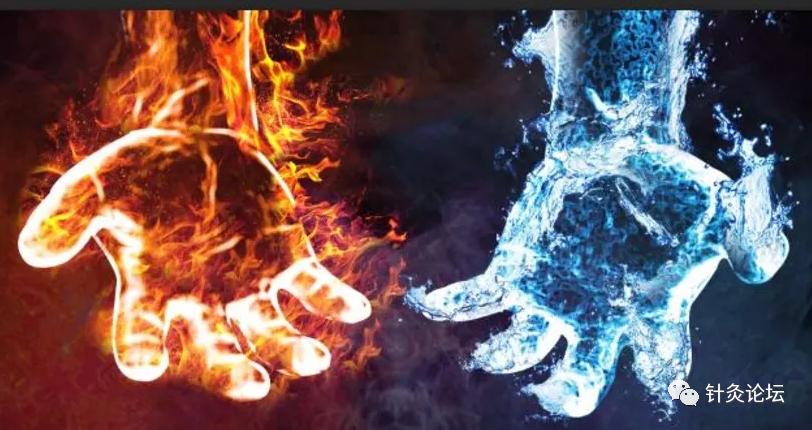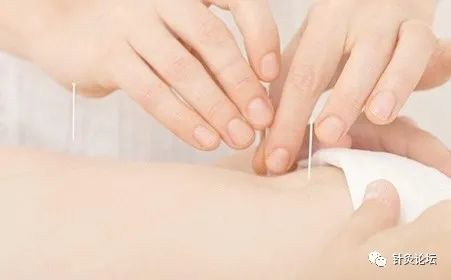Based on ordinary acupuncture, the characteristics of water and fire are utilized to enhance the therapeutic effects of acupuncture, referred to as “Water Needle” and “Fire Needle” respectively. Water Needle involves injecting substances into acupuncture points, while Fire Needle involves using a heated silver needle to perform acupuncture treatment at specific points.
Although both belong to acupuncture techniques, they have their own strengths due to the different properties of “water” and “fire”: Water Needle treats various ailments based on different medicinal substances, with the feature of promoting health even in the absence of disease; Fire Needle utilizes its high temperature to disperse tangible ailments such as rheumatoid arthritis and fibroids.

Water Needle, or acupuncture point injection, uses a standard syringe, with volumes ranging from 1 to 20 milliliters depending on the injection site. The medicinal liquid is injected into the acupuncture points, guided by the theory of meridians, integrating the effects of meridians, acupoints, and medicinal properties to align the therapeutic effects of the acupoints with the pharmacological effects of the medicine. This allows for the highest efficacy of both the acupoint and the medicine. Therefore, acupuncture point injection combines the effects of acupoint therapy and pharmacological action.
In clinical practice, a wide range of medications are used for acupuncture point injections, including various Chinese and Western injectable solutions, as well as more specialized options like autologous blood injections and bee venom injections. Some injections use a single type of medicinal liquid, while others may mix or alternate between two or more liquids.
If the body is free of pain, acupuncture point injection (Water Needle) can achieve health-promoting effects based on the combination of acupoints and medicinal compatibility. Unlike dietary therapy or exercise, acupuncture point injection can directly inject high-purity medicinal extracts into acupoints, significantly improving the absorption and utilization of the medicine.
Currently, commonly used injections include Astragalus (Huang Qi) injection and Compound Angelica (Fu Fang Dang Gui) injection. Astragalus injection is known for its ability to tonify Qi, strengthen the body’s defenses, nourish the heart, promote circulation, strengthen the spleen, eliminate dampness, tonify Qi, raise Yang, stabilize the exterior, stop sweating, expel toxins, promote pus drainage, reduce swelling, and promote tissue regeneration. It can be used to treat conditions such as sweating disorders, allergic rhinitis, cough, asthma, organ prolapse, gastritis, chronic fatigue syndrome, and urticaria.
Compound Angelica injection primarily consists of Angelica (Dang Gui), Chuanxiong (Chuan Xiong), and Safflower (Hong Hua), and is effective in promoting blood circulation, relieving pain, and dispelling blood stasis. It can be used for primary dysmenorrhea, amenorrhea, cervical spondylosis, shoulder periarthritis, headaches, low back pain, and sciatica.
Additionally, other medications used for acupuncture point injections include placental tissue fluid, deer antler essence injection, Salvia (Dan Shen) injection, Xiang Dan injection, Chuanxiong injection, Houttuynia (Yu Xing Cao) injection, Qing Kai Ling injection, Vitamin B1, Vitamin B12, and Vitamin B6.
Fire Needle is one of the ancient acupuncture methods, also known as “Burning Needle,” “Quenching Needle,” or “Burning Acupuncture.” The instrument used is a large needle from the ancient nine needles, which is heated until red and then quickly inserted into the acupoint. By harnessing the power of “fire,” it combines the effects of acupuncture and moxibustion, directly stimulating the body’s Qi, warming the internal organs, and enhancing Yang Qi, thus preventing and treating diseases. It is characterized by low cost, rapid effectiveness, short treatment duration, and high safety.

Due to its high temperature, Fire Needle can transform most substances upon contact with fire, and similarly, “tangible” diseases can also be treated. Traditional Chinese Medicine believes that “tangible” diseases, such as rheumatoid arthritis, uterine fibroids, and shoulder periarthritis caused by meridian obstruction, can be treated with Fire Needle.
Locally, Fire Needle can warm and unblock the meridians, accelerate local Qi and blood circulation, improve microcirculation, dissipate stasis, disperse cold dampness, drain heat toxins, and relieve pain. Systemically, after Fire Needle treatment, local stimulation and meridian conduction can regulate the body’s Qi, blood, body fluids, Yin, Yang, and Qi dynamics, restoring the functional activity of the internal organs and achieving relative balance of Yin and Yang.
When using Fire Needle to treat diseases, the burning of the needle is a key step. The “Great Compendium of Acupuncture and Moxibustion: Fire Needle” states: “Burn until red on the lamp, and it will be effective. If not red, it cannot dispel disease and may harm the patient.” Therefore, the needle must be heated until red to be effective. Regarding the depth of needle insertion, the “Great Compendium of Acupuncture and Moxibustion: Fire Needle” records: “Avoid too deep, as it may injure the meridians; too shallow cannot dispel disease; the depth should be moderate.” The depth of Fire Needle insertion should be determined based on the condition, constitution, age, and the thickness of the muscle and depth of blood vessels at the insertion site.

Although Fire Needle therapy has effects such as expelling necrotic tissue, draining pus, clearing heat and detoxifying, softening masses, promoting tissue regeneration, and relieving spasms, it is not suitable for everyone: it should not be used during acute phases of skin diseases such as psoriasis and flat warts; caution is advised when using Fire Needle on the face; elderly, weak individuals, children, and pregnant women should use Fire Needle with caution; individuals who are overly tense or intoxicated should avoid Fire Needle; critically ill patients, such as those with severe organic damage to the heart, liver, or kidneys, and diabetic patients should use Fire Needle with caution.
Note:All acupuncture methods mentioned in this article are for reference and learning by professional TCM practitioners only, not to be used as prescriptions. Please do not attempt to use them blindly; this platform does not bear any responsibility for any consequences arising from such use!

Follow to view
After following the platform, reply with a number to view the corresponding content
Reply ‘0’ to view: Huangdi Neijing (The Yellow Emperor’s Classic of Medicine)
Reply ‘1’ to view: Jin Kui Yao Lue (Synopsis of Prescriptions of the Golden Chamber)
Reply ‘2’ to view: Shang Han Lun (Treatise on Cold Damage)
Reply ‘3’ to view: Zhong Yao Xue (Study of Chinese Medicinal Herbs)
Reply ‘4’ to view: Fang Ji Xue (Study of Formulas)
Reply ‘5’ to view: Wen Bing Xue (Study of Warm Diseases)
Reply ‘6’ to view: Zhong Yi Mai Zhen Xue (Study of TCM Pulse Diagnosis)
Reply ‘7’ to view: Shen Nong Ben Cao Jing (Shen Nong’s Classic of Materia Medica)
Reply ‘8’ to view: Zhong Yi Ji Chu Li Lun (Foundations of TCM)
Reply ‘9’ to view: Zhong Yi Zhen Dui Xue (Study of TCM Diagnosis)
Reply ’10’ to view: Zhong Yi Yang Sheng Xue (Study of TCM Health Preservation)
Reply ’11’ to view: Zhong Yi Jiu Liao Fa (Study of TCM Moxibustion Therapy)
Reply ’12’ to view: Ai Jiu Gua Sha An Mo [Disease Encyclopedia]
Reply ’13’ to view: Tui Na Ji Chu Xue (Basics of Tui Na)
Reply ’14’ to view: Lin Chuang Tui Na Xue (Clinical Tui Na)
Reply ’15’ to view: Zhong Yi Shou Fa (TCM Manual Therapy)
Reply ’16’ to view: Zhong Yi Jing Luo Shu Xue (Study of TCM Meridians and Acupoints)
Reply ’17’ to view: Zhong Yi Zhen Jiu Xue (Study of TCM Acupuncture)
Reply ’18’ to view: Acupoint Inquiry
Reply ’19’ to view: Dong’s Unique Acupoints
Reply ’20’ to view: Dong’s Unique Acupuncture
Reply ’21’ to view: Ling Shu Acupuncture
Reply ’22’ to view: Ni Hai Xia’s TCM Acupuncture. I Ching and Heavenly Calendar
Reply ’23’ to view: Zhong Yi Nei Ke Xue (Study of TCM Internal Medicine)
Reply ’24’ to view: Zhong Yi Fu Ke Xue (Study of TCM Gynecology)
Reply ’25’ to view: Zhong Yi Er Ke Xue. Xiao Er Tui Na (Study of TCM Pediatrics)
Reply ’26’ to view: Zhong Yi Xiang Xue [Palmistry and Physiognomy]
Reply ’27’ to view: Systematic Anatomy
Reply ’28’ to view: TCM Practitioner’s Examination
Reply ’29’ to view: Shi Xue Min’s Acupuncture Series 123
Reply ’30’ to view: Medical Ancient Texts
Click below to read the original text and access free online videos

